Why does sunlight make me sneeze? What causes air turbulence? Why do energy-saving lights take time to warm up? In this week's question and answer show we also investigate why microwaving a dishcloth causes it catch fire, whether mining could change the Earth's orbit and why streetlights shine with an orange glow. In the news, meanwhile, how electrical brain stimulation can make impossible problems tractible, a pint-sized rocket to take spacecraft to the moon and a tornado spotted on the surface of the Sun...
In this episode

01:44 - Thinking cap makes impossible problem soluble
Thinking cap makes impossible problem soluble
A small dose of electrical current passed across their heads enabled a  group of volunteers to immediately solve a puzzle they had previously found to be impossible.
group of volunteers to immediately solve a puzzle they had previously found to be impossible.
This surprising result is the work of Sydney University's Centre for the Mind scientists Allan Snyder and Richard Chi, who have published their results on the "nine dot problem" as it's known in the journal Neuroscience Letters.
This puzzle, which has thwarted study volunteers for over a century and, under laboratory conditions, is expected to have a solution rate of 0%, involves connecting a pattern of 9 dots - arranged in a 3x3 grid - using four straight lines drawn without lifting the pen from the paper or retracing any lines.
Twenty two volunteers in the Sydney study were initially unable to solve the problem during a 9 minute period. Half of the group then underwent ten minutes of transcranial direct current stimulation, which involved passing a 2 milliamp current across their heads with the positive electrode applied to the right temple and the negative electrode on the left.
Following this treatment, 40% of the subjects then solved the problem. A control group meanwhile, to whom the electrodes were attached but no electrical current applied, were still unable to solve the problem.
According to Snyder and Chi, people find this puzzle so difficult because the dominant left temporal lobe uses prior knowledge of shapes to interpret the pattern of dots as a square with imposed rigid boundaries. And as the solution requires drawing lines outside of this shape, subjects think "inside the box" and don't spot it.
The electrical current, however, boosts activity on the more creative right side of the brain and reduces the activity in the creativity-suppressing left side, freeing the subject from their existing cognitive biases and enabling them to see the solution.
Intriguingly, one subject recruited by the researchers but not included in the analysis did immediately solve the puzzle without the benefit of electrical stimulation. But, on further questioning, he revealed having had a head injury as a child that damaged his left temporal lobe.
This supports their theory, the researchers say, concluding that brain stimulation has the potential to facilitate those tasks that our minds are not well adapted for.
Why do low energy lightbulbs take so long to reach full brightness?
Dave - This is all to do with how an energy saving light bulb works. Conventional old-fashioned light bulbs basically work by putting a lot of electricity through a very thin wire, which gets very, very hot. When something is hot, it glows. At about 2000 degrees centigrade, which is the temperature of the filament in a normal light bulb, it glows close to white; a slightly yellowish white. The problem is that about 90% of the light given out at that temperature is actually the in the infrared region. So it's a hideously inefficient way to make light.
Chris - It's just giving you heat which you can't see.
Dave - Yes, you can't see it, so it's entirely wasted. Energy saving light bulbs create light in a very different way. You give energy to a mercury gas, by passing a spark through it. That then gives the atoms extra energy, which they then release in the form of ultraviolet and very, very little infrared. The ultraviolet light then gets converted into visible light by some phosphors on the inside of the tube. These are the things which are added to your clothes to make them appear brighter in the sunshine and the reason why your clothes glow if you go into a nightclub. The problem is that mercury is normally a liquid at room temperature, so if it is cold, the mercury isn't much of a gas. So the light has got to warm up a bit until there's enough gas in there to produce full brightness.
Why aren't they as bright as they should be, compared to a normal light bulb? Well that's probably mostly to do with manufacturers being slightly optimistic about how bright they actually are!
Chris - So, if you put more of the ingredients in and a bit more energy, you should be able to get the same amount of light. They're just being a bit over ambitious.
Dave - Yes, I think they used to quote it as being 7 times more efficient than a conventional light bulb. These days they're supposed to use 5. I think with 5 then they should be equivalently bright.

Why do I sneeze on sunny days?
Chris - I think you've got what's called the photic sneeze reflex. Photic as in light; Sneeze as in, well, sneeze! This is apparently genetic, it seems to run in families. Do you have any family members who do the same thing?
Paul - I don't actually, no. I've got family members, but I'm the only one that does it!
Chris - Okay. It affects about 1 person in 5 and what scientists think is going on is that there's a little bit of miswiring in the brain stem, which is the thing that connects the spinal cord to the main part of the brain which is where all of the circuitry is to control the size of your pupils and blinking, and that kind of thing. So when a bright light shines into your eye, neural circuits get activated to cause a blink and your pupil to shrink - pupilloconstriction. Some of this nerve activity also spills over into the parts of the nervous system that detect irritation in your nose and they trigger a sneeze.
People used to think it was because sunlight made your eyes water and that the tears running down into your nose tickled your nose a little bit, and that triggered the sneeze. But when they did careful studies and in fact, the military have been researching this because what you don't want is someone who's flying a supersonic jet to suddenly develop the photic sneeze response when they're flying into the sun and then have a fit of sneezing at the flight controls doing a thousand miles an hour! So they were looking into this and they ruled out the tears tickling the nose, and they think it's actually this miswiring and it does appear to be as I say, familial. So, you get some people who have it sporadically and some who say, "Yup! Lots of people in my family have this." So you have the photic sneeze reflex.
It happens to me when I get up in the morning in the winter time and I go into my shower where the lights are very bright, and you turn the bright lights on. All of a sudden you go from dark to very bright and I have this sneezing fit.

How did the Universe come by its angular momentum?
You don't actually have to have any overall rotation in the whole universe for objects within the universe to be rotating in various different directions.
Imagine that you have a large cloud of gas that has no rotation to begin with, but that you split it up into lots of little pieces which go on to form into lots of different galaxies. Each piece by random chance will have some particles which are swirling around in some particular direction, and others which are swirling around in other directions, so it will have some very tiny rotation in some particular direction. Now as that cloud collapses down to form a star or a galaxy, there's an effect called the conservation of angular momentum which means that spin is accelerated as the object gets smaller.
That's similar to the effect when a figure skater is skating on ice and they start off spinning quite slowly, when they pull their arms in you'll see they start spinning incredibly quickly. So, that means that an object, even if it only has a tiny rotation to begin with, can actually end up rotating quite appreciably as we see planets and stars in the universe doing. Certainly, if you look at the rotations of different stars, you will see that smaller stars tend to rotate much more quickly than bigger stars and that is because they're being spun up as they've contracted down.

What causes elliptical planetary orbits?
Dominic - The simplest kind of orbit is a circle, where the planet is trying to travel in a straight line which is carrying it further away from the star it's orbiting around.
But the gravitational pull of the star in a particular direction is pulling it back, so it's staying at a constant distance from the star as it goes all the way around that central star.
Now, if you imagine that planet had slightly less speed, then it wouldn't have enough speed to keep at the same distance from the star, so it would begin to fall in towards the star. As it begins to fall in, it will start to move much more quickly, because the star is pulling it in and it's gaining kinetic energy.
But it's then moving too fast to be in a stable circular orbit that much closer to the star. So, it then has enough energy to move back out again.
So, it's "wobbling" in its distance from the central star, which makes the orbit elliptical
Where does air turbulence come from?
Dave - When you're flying through the air at about 500 miles an hour, if you're flying through beautifully smooth air; air which is not moving at all, or it's all moving at the same speed, you'll have a nice smooth journey. But you can be in complicated messy air; where wind is blowing off a rough surface or where the air is moving upwards, other areas where the air is going downwards, and yet more where it's going sideways. As a plane flies through these, it will suddenly be flying too fast and have too much lift, making it go upwards. Then it will suddenly be flying too slowly, so it will go downwards. So it will get shaken around because it's going through these little pockets of moving air very quickly and you feel that as being shaken around all over the place.
The issue with aircraft not being able to fly very close to each other is related. When a plane flies through the air, it's pushing lots of air downwards over its wings. The air at the side isn't getting pushed downwards, so it gets lifted upwards and you get these two swirls, two vortices, one at the end of each wing. From a small plane, that's not very dangerous, but for something like a 747 or A380, those are incredibly powerful. There's a huge amount of energy in these things and if a small aircraft gets caught in one of those behind a large aircraft, it can get flipped upside down, and could crash really viciously.
Chris - So you don't want them too close for that reason which is also why midair collisions or near misses are so important as well I suppose.
Dave - Yes, if you had a near miss flying into these vortices, wake vortices from another aircraft, you could cause problems but it's not as bad as near the ground. If you're up high, you've got more time to deal with the fact that you are now upside down. If you're at 100 feet, you don't have any time at all and it's very messy.
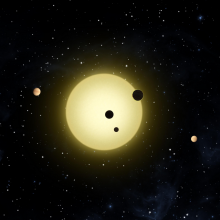
14:28 - Life's building blocks found in a ring around the Sun
Life's building blocks found in a ring around the Sun
Complex carbon-based molecules, including many that are important for life on Earth, could have formed in the early solar system. That's according to a paper by Fred Ciesla and Scott Sandford in this week's issue of the journal Science, based on their computational simulations.
The origin of these prebiotic molecules has been a long-standing puzzle. In order for simple stable molecules such as carbon dioxide and methanol to rearrange themselves into more complex configurations, two conditions are thought to be needed.
In order to break the simple configurations apart, ultraviolet light is needed, and in order for the fragments to then be rearranged into different configurations, a heat source is needed. Until recently it was thought that all of the organic material on Earth had originated in situ, helped by lightningstorms in the Earth's early history.
However, recent evidence is that organic molecules are quite widespread in the Universe. They have been found on interplanetary dust grains and in meteorites arriving on Earth; furthermore, their spectral signatures can be seen in many star-forming nebulae far beyond our own solar system. This suggests that they can form in a much more widespread environment than simply the atmospheres ofplanets.
Until now, the early solar system had been ruled out as such an environment. The protoplanetary disk of gas and dust which formed into the planets was so dense that only its innermost parts would have been exposed to the Sun's ultraviolet radiation.
But writing in Science this week, Ciesla & Sandford report on computational simulations of the migration of material within such disks, taking into account effects such as the evolution of the disk and the turbulence within it.
They conclude that there would have been very significant mixing of material as the solar system was forming, and that much of the material would at some point, by random chance, have found itself elevated slightly out of the top or the bottom of the disk. Here, it would have had a clear line-of-sight to the Sun.
Even if this only happened for a thousand years for a typical dust grain, out of a total lifetime of around a million years for the disk, that would have been enough time for substantial chemical changes to occur.
By comparing their simulations with laboratory experiments to determine the amount of ultraviolet irradiation needed to produce chemical changes, Ciesla & Sandford conclude that this would have been ample time to account for all of prebiotic molecules found in the solar system today.
The question remains as to how these molecules went on to form still larger and more complex molecules, such as amino acids and proteins, and how these eventually led to life on Earth, but forming the prebiotic building blocks is an important step along the way.

17:28 - The National Astronomy Meeting 2012
The National Astronomy Meeting 2012
with Ben Valsler, The Naked Scientists
Ben - NAM is the annual meeting of the Royal Astronomical Society. Although this year was a little bit special because it was in partnership with the German Astronomical Society, the Astronomische Gesellschaft. It's sponsored by the STFC and also the University of Manchester as this year's event was held in Manchester University. There were nearly 1,000 delegates, hundreds and hundreds of presentations, exciting public events, plenaries, and some fun social events as well.
Chris - Now off course, you make
Naked Astronomy which is our podcast that Dominic also appears on so I presume this is going to turn into an episode of Naked Astronomy. But without giving the game away too much, what were the top stories that you saw this week?
 Ben - Well, the one that seems to have really gathered the most coverage is an image that's been called the "billion stars photograph" even though there are actually far more than a billion stars in it. It's a photograph of the Milky Way put together by people at the University of Edinburgh from images taken by two different infrared telescopes. There's the UK infrared telescope in Hawaii, and Vista which is in Chile. All in all, it comes to 150 gigapixels. If you think that your digital camera might be 10 megapixels, that's 1500 photos tiled next to each other. They worked out that if you were to print it out, it would be about 200 metres wide. So it's a huge image and it's an image of our Milky Way.
Ben - Well, the one that seems to have really gathered the most coverage is an image that's been called the "billion stars photograph" even though there are actually far more than a billion stars in it. It's a photograph of the Milky Way put together by people at the University of Edinburgh from images taken by two different infrared telescopes. There's the UK infrared telescope in Hawaii, and Vista which is in Chile. All in all, it comes to 150 gigapixels. If you think that your digital camera might be 10 megapixels, that's 1500 photos tiled next to each other. They worked out that if you were to print it out, it would be about 200 metres wide. So it's a huge image and it's an image of our Milky Way.
Chris - Nice, but why is it important?
Ben - Well, it's very useful for testing algorithms that are designed for spotting interesting or unusual objects and it's part of something called the Vista Data Flow System. The idea is that we use this to calibrate new telescopes and essentially to archive astronomical data so people can easily use that image to give us an idea of what is actually there at a given time in the Milky Way.
Chris - Meteors?
Ben - It's also been found that Jupiter and the resonant orbits between Jupiter and Haley's Comet are responsible for when we get spectacular meteor showers which are known as meteor outbursts. There was one of these back in 1993, another in 2006, and now, researchers at Armagh Observatory in Northern Ireland think that this is because of the gravitational impact of Jupiter which slightly restricts the orbit so that you get a bunching up of the stuff that falls out of Haley's Comet. When we then go through that bit of the tail in Earth's orbit, we get this spectacular meteor shower.
Chris - But we've got to live another - I don't know- 70 years, 60 years to see it, haven't we now?
Ben - Well, the next one is going to be in 2070, yes, but they do argue that there's still an awful lot of good science that we can do between now and then.
Chris - Terrific! And finish this up by telling us about the dark energy material they presented.
Ben - Well this is based on the Sloan Digital Sky Survey 3 (SDSS-3) and using a survey called BOSS - that's Baryon Oscillation Spectroscopic Survey. What they've done is looked at over 250,000 galaxies and essentially done a statistical analysis where you can see how they clump together, and the clumping together can give you some idea of the waves that formed in the very, very early universe before atoms even condensed out of the incredibly hot plasma.
These waves got "fixed" in place so if we look at these waves at different times, we can look at the expansion of the universe by looking at the size of those wavelengths. Researchers working on BOSS have worked out that dark energy, this incredible force that is driving the expansion of the universe to get faster and faster, seems to have taken over somewhere between 5.5 and 6.5 billion years ago. Before that, the dominant force in the universe was gravity holding everything together and after that, it's been dark energy that's been causing the universe to expand. That won a Nobel Prize when it was first discovered. So now, working out what it is that's doing it is a big question in astronomy.

21:39 - Ancient Raindrops provide Insight into our Early Atmosphere
Ancient Raindrops provide Insight into our Early Atmosphere
with Roger Buick, University of Washington
Chris - What was the atmosphere like on the Earth nearly 3 billion years ago? Well that's a pretty tough question to answer, but incredibly, some fossilised raindrops or rather, the patterns that they left behind when they fell 2.7 billion years ago have enabled scientists to reconstruct some aspects of what the air that rain fell through would've been like. And with us to explain how, from the University of Washington in Seattle is Roger Buick who's one of the authors on the study. Hello, Roger.
Roger - Good day!
Chris - So what are you actually trying to understand about the early atmosphere?
Roger - What we really want to know is why the Earth wasn't an ice ball 3 billion years ago. The Sun was only 80% as bright then as it is now and if the atmosphere was the same as it is now on the Earth, the planet should've been completely frozen over.
Chris - Yet we've got geological evidence of their having been running water and quite a balmy climate.
 Roger - There's abundant geological evidence for liquid water - oceans, rivers, lakes, and now rain as well. Either we had to have a much denser atmosphere, or else we had to have a whole lot more greenhouse gases in the atmosphere to keep us warm. And there's been a debate going on for 20 odd years as to what sort of atmospheric warming mechanism was active on the early Earth.
Roger - There's abundant geological evidence for liquid water - oceans, rivers, lakes, and now rain as well. Either we had to have a much denser atmosphere, or else we had to have a whole lot more greenhouse gases in the atmosphere to keep us warm. And there's been a debate going on for 20 odd years as to what sort of atmospheric warming mechanism was active on the early Earth.
Chris - And obviously, without the capacity to go back 3 billion years or so and take a snapshot of that atmosphere, we're forced to rely on indirect measures which I guess is what you've done in this paper in Nature this week. You've used an indirect measure to work out what the atmosphere must have characteristically been like.
Roger - Yeah, well until Torricelli invented the barometer, we've really got no real readings of what atmospheric pressure was like early in Earth history. The atmosphere has a very, very indirect and faint impact on rocks that can get preserved from early in Earth history. So, to be able to register anything about the atmosphere from early in Earth's times is really quite remarkable.
Chris - So how did you actually do this?
Roger - Well, we found some literature records of raindrop imprints in rocks, almost 3 billion years old. There's a number of places in the world where there are these ancient raindrop craters and the best ones that we were able to come across were in South Africa, out in the Karu-velt of South Africa. And so, we went there and took samples of them and made latex peels off them and measured them. Now there's a relationship between the size of raindrop imprints and the speed at which the rain fell, and the speed at which the rain fell is influenced by the atmospheric density. The denser the atmosphere, the slower the raindrops fall, so the smaller the little craters that they form.
Chris - So how do you work out based on the rock samples that you've got from 3 billion years ago, how big the crater should be in proportion to the speed of the raindrops? How did you close that gap in our knowledge?
Roger - Well, the big variable is the nature of the material being impacted. The South African raindrop imprints were in volcanic ash, so what we did was get some equivalent modern volcanic ash from the Icelandic eruption a couple of years ago and did experiments by dropping artificial raindrops down a 7-floor stairwell onto a pie plate full of this volcanic ash...
Chris - It's high tech stuff, this! And so, that was your sort of proxy measure. You could see based on how fast or therefore how much energy, how much momentum, the raindrops had and based on how big a splatter imprint they make you can extrapolate from the latex peels from the South African rocks, how fast the raindrops must've been going 2.7 billion years ago.
Roger - Exactly. The other variable of course is the size of the raindrop. As anybody British will know, raindrops vary greatly in size depending on the intensity of the rainfall.
Chris - Well at the moment, we're in drought in the southeast, so we don't have any rain at all. Zero is the size! So what did you do to constrain that?
Roger - We do know that there is an absolute maximum size to which raindrops can get. It's a proportion of the interplay between the surface tension of the water and the force of gravity trying to pull it to bits. And so, the largest that's ever been recorded on the Earth and the theoretical maximum size from physics is 6.8 mm. So, that sets a maximum bound on what the atmospheric pressure could've been, but it's unlikely that the absolute maximum raindrop size was achieved. Probably more like 5 mm was the realistic maximum raindrop size.
Chris - So putting all that together, what does this tell us about the atmosphere 2.7 billion years ago when these - what are now rocks - were just volcanic ash and this moderate shower was falling on them?
Roger - Well, it us tells that the maximum possible atmospheric pressure was about 1.6 bars, so 1.5 times what it is now, but more likely, it was 1.1 bar, 1.1 atmospheres, well maybe even as low as 0.6 of a bar, so only 6 tenths of our current atmospheric pressure.
Chris - So very, very similar to what we have today which argues that we couldn't have had just this blanketing smog of CO2, giving us an artificial greenhouse effect to keep the Earth warm then.
Roger - That's right. Most likely, we had to have some other sort of greenhouse gas other than just carbon dioxide in the atmosphere to warm the Earth. Maybe something like methane, though that's problematic; if you have high levels of methane in the atmosphere, you produce a haze of organic particles formed by ultraviolet light and that reflects sunlight and has an anti-greenhouse effect. Other possible greenhouse gases would be, my favourite is laughing gas - nitrous oxide. There is some evidence that there was a biological nitrogen cycle producing laughing gas, back as far as about 2.7 billion years ago. So, laughing gas is something like 100 times more effective as a greenhouse gas than carbon dioxide. So we might have had some methane and some laughing gas in the atmosphere as well.
Can mining alter Earth's orbit?
In order to change the Earth's orbit, you've got to somehow apply a force to the Earth. Mining is essentially just moving material around on the Earth; they might dig something out of the ground, move it to the top of a skyscraper or even burn it and move it into the atmosphere. Now, this could conceivably have a very, very tiny effect on how the Earth is rotating because if you change the shape of the object, it will change how it rotates. But you're not applying any forces to anything else in the Universe, so you can't affect how the Earth is moving. The only conceivable way it might slightly affect things is you might get very, very minute effects where a slightly differently shaped Earth might feels tides from the moon and other planets. These would be microscopically different, but could slightly change the Earth's orbit. But these are going to be tiny effects on tiny effects, on tiny effects. So, far, far, far, too tiny to be measurable.

Why are streetlights orange?
The reason that most streetlights are orange is because they contain the chemical sodium.
Some electricity is passed into the lightbulb and this gives energy to the sodium. Sodium, when it gets excited by the energy, gives out a lot of orange light, making it a very cheap and efficient way to illuminate a very large area.
But to produce white light is very complicated. To make white light you have to mix lots of different colours of light together and it's the mixture that looks white.
The way in which lamp designers make this happen is to use a mixture of different chemicals. When each of those chemicals gets excited they then produce different colours of light which you then see mixed together so it appears to be white.
Because it's more complicated and involves more chemicals, it's more difficult to do and it's more expensive and because orange light does a good enough job, most of the time we use orange sodium lights rather than white ones.
Will solar activity eventually dissipate the Earth's atmosphere?
Eventually, yes it will in about a billion or a couple of billion year's time. The Sun is very slowly warming up and expanding. It's mostly in a steady state balanced between pressure pushing the Sun outwards and gravity pulling the Sun inwards. But over time, the pressure is winning ever so slightly and causing the Sun to expand and get brighter. In terms of the oceans boiling, that's about a billion years away. In terms of the Earth losing its atmosphere, that's a couple of billion years away and it's 5 billion years until the Earth will actually fall into the Sun and we will be burned to a cinder.

32:07 - Pint sized rocket
Pint sized rocket
A rocket has been developed that could get a spaceprobe to the moon on just 100g of fuel
Some tasks can only be done by a large satellite, but there are many others which can be done as well if not better with several smaller ones. Any measurement which requires measuring something in more than one place, like magnetic field, solar wind or gravity, is much better done with more small probes, as could be exploring a planet where 20 small rovers can cover more ground than one big one.
These nanosats have been gaining in popularity, but so far they have had no way of moving, chemical rockets need a lot of heavy fuel, because the exhaust gasses move out of the back of the rocket relatively slowly so each gram of fuel only gives a limited push. Electric ion thrusters, throw xenon gas out of the back of the rocket 10 times faster than a chemical rocket so use a tenth of the fuel, but they are complex, involving piping gas about, valves and other devices which don't miniaturise easily.
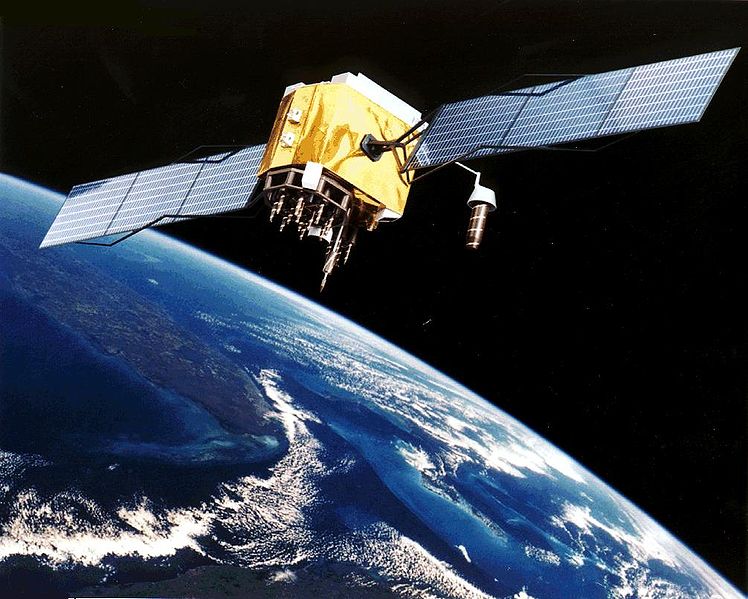 However the Dutch company EFPL has managed to build an ion thruster which could weigh as little as 200g including the fuel. They have simplified the design by instead of using a gas as the fuel, using an ionic liquid, this is a liquid made up of positive and negative ions, a bit like molten salt, but which will stay liquid in the cold of space, and won't evaporate. They move this liquid from the tank to the thruster which is made using similar processes to a computer chip using capillary action, and then accelerate the ions out of the back using an alternating high voltage, first pushing out the positive then the negative ions out of the back producing thrust. This thrust is minute equivalent to the weight of a square cm of paper on earth, but in space there is no friction, and the rocket can keep firing for years, allowing it to move a long way.
However the Dutch company EFPL has managed to build an ion thruster which could weigh as little as 200g including the fuel. They have simplified the design by instead of using a gas as the fuel, using an ionic liquid, this is a liquid made up of positive and negative ions, a bit like molten salt, but which will stay liquid in the cold of space, and won't evaporate. They move this liquid from the tank to the thruster which is made using similar processes to a computer chip using capillary action, and then accelerate the ions out of the back using an alternating high voltage, first pushing out the positive then the negative ions out of the back producing thrust. This thrust is minute equivalent to the weight of a square cm of paper on earth, but in space there is no friction, and the rocket can keep firing for years, allowing it to move a long way.
The first use they want to make of this rocket is on a satellite called clean space 1, which aims to launch in 3-5 years time and is designed to tidy up old defunct satellites and other space junk by capturing them and dragging them into the atmosphere. Though the same rocket design could be used for small cheap satellites in earth's orbit which need to maintain their position, or for missions to the moon, which would only take 100g of fuel for a 1kg probe, or even further into the solar system, opening up the possibility of cheaply reaching the moon or even further out into the solar system, opening up all sorts of interesting scientific possibilities.
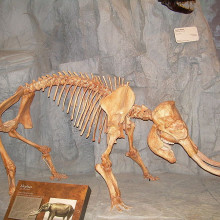
36:06 - Dwarf Elephants - Planet Earth Online
Dwarf Elephants - Planet Earth Online
with Victoria Herridge, Natural History Museum
There's an awful lot that scientists can learn about the past from fossils but one particular extinct species is proving a tough nut to crack. Dwarf elephants last roamed the Earth more than 10,000 years ago. About a metre tall fully grown, they are even considered by some to be responsible for the legend of the one eyed cyclops. But although they have been studied for 150 years, fundamental information about dwarf elephants is still missing and no one is exactly sure how the different species evolved. Palaeontologist Victoria Herridge from London's Natural History Museum is part of an international project trying to solve the mystery. Victoria studies dwarf elephant fossils found on a number of Mediterranean islands. Sue Nelson went to meet her in one of the museum's basement stores...
Victoria - In here, we have a whole draw full of dwarf elephant teeth from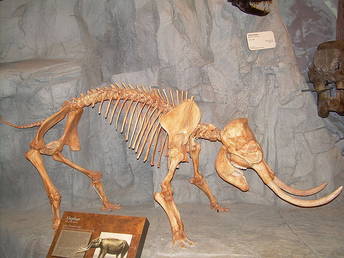 Cyprus. They're all different sizes but most of them are smaller than the size of my hand which sounds quite big for a tooth, but for an elephant tooth, that's absolutely tiny. They have six teeth through their life and as the elephant grows bigger, their teeth grow bigger. So the smaller teeth are actually the teeth of younger elephants. It seems that on islands when big animals become isolated, they tend to evolve to become smaller and conversely, the small animals, like mice and rats, tend to evolve to become larger, which is an interesting phenomena we call the 'Island Rule.'
Cyprus. They're all different sizes but most of them are smaller than the size of my hand which sounds quite big for a tooth, but for an elephant tooth, that's absolutely tiny. They have six teeth through their life and as the elephant grows bigger, their teeth grow bigger. So the smaller teeth are actually the teeth of younger elephants. It seems that on islands when big animals become isolated, they tend to evolve to become smaller and conversely, the small animals, like mice and rats, tend to evolve to become larger, which is an interesting phenomena we call the 'Island Rule.'
Sue - As this project wants to look at the different environmental changes and the effect that had on the species, I assume then that that means that you suspect that the changing climate had something to do with their evolution, why they became the size they did and perhaps why they became extinct as well?
Victoria - Yes, it's certainly a possibility. If you look at modern day islands, we know that the number of species that live on an island is related to how big the island is and also, how difficult it is to get to that island from the mainland. So because there's this relationship, it seems sensible to assume that that islands and the animals that live on them might be affected by sea level change. So, if the sea level were to rise as we fear it might do in the next few years, you would effectively see a greater impact of that on islands. So using that as a starting point, we then thought - the period we're interested in, which is called the Quaternary - the last 2 ½ - 3 million years - a lot of that was characterised by these shifts between ice ages and warm stages, and that will then be followed by a rise in sea level. So we think for instance at the peak of the last ice age, the sea level was 120 meters or so lower than it is now. Yeah, so quite an extreme difference.
But because it has happened several times, about every 100,000 years, what you've got there is a repeated example of this situation changing. So we aren't looking at the effects of the climate per se, it's more of the associated impacts of that climate change, i.e. sea level change that may affect the environment in which animals find themselves. Now, Sicily is very, very close to mainland Italy, but the sea that separates the two is about 100 metres or so deep. And so, 120 metres of sea level drop would join Sicily to the mainland. It would also join Malta to Sicily and so, at low sea level, what you might get is, the mainland reaching out and encompassing Sicily and Malta, and that would become part of the mainland. Now, when the climate shifted again and you've got a change from say, an ice age back to a warm stage then of course, sea level would rise and you'd find yourself with two islands, Sicily and Malta. The animals that were there, that had been effectively been mainland animals until that sea level change, now become isolated on these islands and it's following that isolation that we think the evolution towards becoming smaller happened. So, we are wondering whether or not you can effectively associate some of these species with some of those climatic driven sea level changes of the past.
If I just lift up this very heavy tooth here...
Sue - Yeah, you need two hands for that one.
Victoria - Yeah, two hands. This is not going to fit in one hand. You can how heavy it is from the clunk there.
But this is a straight-tusked elephant tooth from Clacton-on-Sea in Essex. So we had straight-tusked elephants in the UK, but that species actually stretched all the way across Europe, down to the far south, so into Greece, into Italy. This makes sense because we think this was probably the ancestral species of these dwarf elephants that somehow reached these islands, perhaps at low sea level, and then became isolated on those islands when the sea level rose again. When it was isolated there, it evolved from being very, very large - a straight-tusked elephant would've been about 4 metres tall, much taller than the African elephant which comes in at about just over 3 metres, and would've weighed about 10 tonnes. Contrast that again with the African elephant, the largest living land mammal that's about 7 tonnes, and it would've evolved on those islands to something as tiny as this 1 metre tall species, and that's a very extreme example of evolutionary change. It's a wonderful example because it obviously happens again and again on different islands.
Because this happens so many times, it starts to give us a natural experiment, these islands are kind of like a natural laboratory for evolution in real space and time. It's a really neat potential way of getting our hands on, how quickly evolution happens, and potentially, how and why it happens. That's why studying these elephant species potentially will give us greater insight into a much broader evolutionary and biological trend.
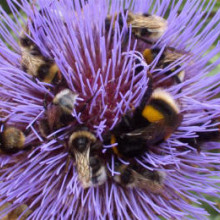
45:15 - Resuscitating Antibiotics and Bumblebees on the Decline
Resuscitating Antibiotics and Bumblebees on the Decline
with Dave Goulson, University of Sterling; Marta Martins, University College Dublin; Huw Morgan, University of Aberystwyth; Daniel Frankel, University of Newcastle
Bumblebee numbers reduced by pesticide use
Direct evidence that pesticides are poisoning bumblebees has been revealed ![The buff-tailed bumblebee (Bombus terrestris) visiting Echinops (Globe thistle). Queens and males of this species can be distinguished from the white-tailed bumblebee (Bombus lucorum) by the buff colour of their tail. Workers are more problematic, as the tail is mainly white. However, a fine margin of buff hairs between the white and black bands is usually diagnostic. (c) Penny Frith [PLACEHOLDER, WS#-1]](/sites/default/files/media/Bonbus_Terrestris_05.jpg) this week in the journal
this week in the journal
Science.
By exposing colonies of bumblebees to the commonly used pesticide imidocloprid, Dave Goulson from the University of Stirling found that the bee colonies grew more slowly and there was an 85% reduction in the production of new queens who are crucial for producing future bee generations.
The consequences could be significant for both the environment and the economy...
Dave - If we're accidentally poisoning our bumblebees and driving down their populations, there'll be less pollination for wild flowers and therefore, all the things that those plants support, all the butterflies and birds, and everything else. But there's also a really direct economic importance of bees. Bumblebees are the main pollinators of some of the very nice things that we like to eat - so blueberries, raspberries, strawberries, lots of garden vegetables like beans and tomatoes. So, if we lose our bumblebees, then our diets are going to be much be poorer for it.
---
Resuscitating Antibiotics
Bacteria that have become resistant to antibiotics could be made susceptible to the drugs by the addition of certain chemical compounds.
Presenting at the
Society for General Microbiology annual meeting in Dublin this week, Marta Martins from University College Dublin, combined one of five known pharmaceutical compounds, including phenothiazines used to treat schizophrenia, with the widely prescribed antibiotic ciprofloxacin.
When used on samples of bacteria showing resistance, the combined treatment was six times more effective at killing bacteria than samples lacking these added compounds, giving a new lease of life to the drugs...
Marta - We think this is a better solution instead of developing new antibiotics. With these compounds that are known antibiotics, they are synthetic compounds and we could avoid that problem of the bug adapting to that. It will not just help to treat these multidrug resistant infections but also to decrease the numbers that we will see in the hospital and subsequentially in the community.
---
Solar tornado
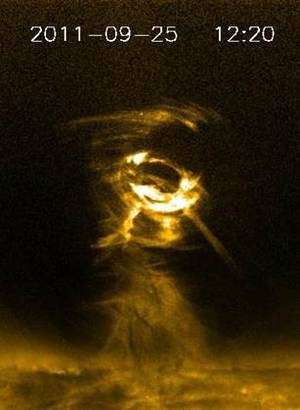 Scientists have spotted a tornado on the Sun, large enough to accommodate several hundred Earth-sized planets.
Scientists have spotted a tornado on the Sun, large enough to accommodate several hundred Earth-sized planets.
Using the orbiting Solar Dynamic Observatory, University of Wales, Aberystwyth physicist Huw Morgan and his colleagues spotted the 120,000km high plasma tornado travelling across the Sun's surface at speeds of 300,000 km per hour, driven by the solar magnetic field.
The discovery was announced this week at the
National Astronomy Meeting in Manchester.
Huw - It's a huge structure and it lasts for 4 or 5 hours, and it's very exciting because it's a test bed for various theories on solar magnetic field and plasma movements in that field.
---
Robots mimicking Living Organisms
And finally, a robot less than 1cm in size with the ability to respond and move like a living organism is being developed by scientists at the University of Newcastle.
Modelled on an ancient fish, the robot named '
cyberplasm' will combine cells engineered to sense light and chemical cues that feed into a central processor that controls a series of artificial muscles resulting in movement.
Daniel Frankel from the University of Newcastle is leading the project.
Daniel - The idea is really to harness the power and control of the biological system. For example, muscle contraction and sensitivity of cells and interface them and incorporate them into a machine. The ideal uses would be swimming into waters which may be polluted or having toxins and detecting toxins, and then in addition, medical applications. For example, reconnaissance in the body so to speak, swimming through the arteries and veins, and trying to detect and maybe even treat various diseases.

55:25 - Why doesn't my body make best use of my energy reserves?
Why doesn't my body make best use of my energy reserves?
We put this question to Professor Stephen O'Rahilly from the Institute of Metabolic Science at Addenbrookes Hospital and Dr. Giles Yeo from Cambridge University... Stephen - My name is Stephen O'Rahilly and I work in the on the Addenbrooke's campus. The signals to eat and the signals to be hungry seem to be generated from within the brain. Two of the key signals that allow the brain to access information about the state of nutrition are the hormones leptin and ghrelin. Leptin comes from fat tissue and probably its most important function is that when we become too thin and the leptin level drops in the blood below a certain threshold, then we become ravenously hungry. However, when we have accumulated too much fat, our brain tends to become effectively deaf to the signals coming from adipose tissue. Ghrelin has a rather opposite effect. It's a hormone produced by the stomach and it's an anticipator of meals. It rises before we expect to have a meal and it seems to have a critical role in promoting food intake and promoting our ability to lay down food as fat.
Giles - Given the importance that eating has on keeping us alive, our brain has evolved mechanisms to make sure that it also feels good or rewarding to eat, the "Ooh factor." Certain foods such as energy dense, sweet and sticky desserts trigger the "Ooh factor" better than others, giving us the motivation, making sure we store all the extra energy we can. Remember, we have evolved over tens of thousands of years to stay alive through multiple famines and any increase in motivation to continue to search for food was an evolutionary advantage. Our problem is that after years of natural selection, ensuring that we eat as much as possible to stay alive, we now have to try and adapt to an environment of too much food. Hannah - So, the hunger hormone grehlin spikes before mealtimes giving us learned hunger pangs even if love handles and pot bellies are already kindly storing energy for us around our waists since we have evolved to be motivated by food and seek it out. Andrew Reitemeyer and Aureliano Buendia agree, adding via Facebook, that we are programmed to build up energy reserves and to conserve them as much as possible in preparation for times of scarcity. Our bodies have not necessarily yet learnt to adapt to this new, full fat, environment, and that, coupled with a sedentary lifestyle, makes it difficult for us to fit into our summer swimwear.......
- Previous A Thinking Cap for Problem Solving
- Next How does snake venom work?









Comments
Add a comment